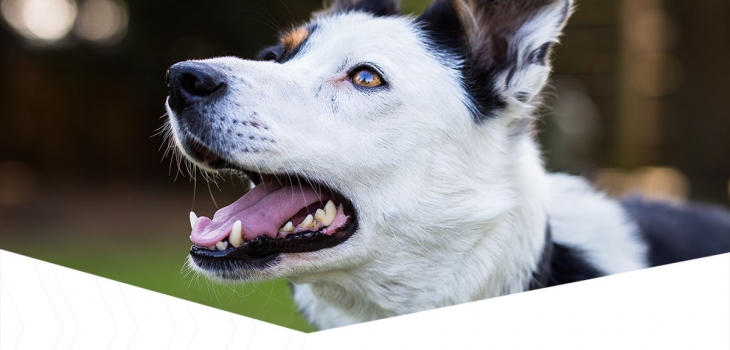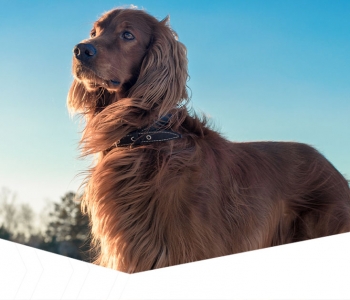
Looking after your dog’s teeth over the festive season
We all know that too much sugar and junk food will rot our teeth but what about our pets? We’re unlikely to be indulging our pets with fizzy drinks and chocolate over the Christmas period, but we still need to think about dental hygiene and where necessary, dental treatment. Here we discuss how we can help keep our dogs teeth in tip top condition.
Human teeth are very different to animals’. Carnivores need teeth for catching and slicing, whereas omnivores need large flat grinding teeth. In humans, a typical adult human has 20 baby teeth and 32 permanent adult teeth. Dogs have 28 baby teeth and 42 permanent teeth.
Pets acquire gum disease in the same way that humans do, with bacteria and trapped food particles collecting along the gum line and forming plaque. If this plaque is not removed, minerals in the saliva then combine with the plaque and form tartar (or calculus), which is firmly attached to the tooth.
This tartar then causes local irritation resulting in gum inflammation (gingivitis). Unfortunately prior to gingivitis, the owner will see absolutely nothing, which is why dental disease is often thought of as a silent disease. If the calculus is not then removed the calculus begins to separate the gum from the teeth, allowing even more bacteria to enter! This is called periodontal disease.
Root canals are commonly performed on our pets to save discoloured, fractured or abscessed teeth. The alternative is full extraction. Some breeds of dogs are also more prone to periodontal disease due to misalignment of their upper and lower jaws and include (but certainly not exclusive to) the toy poodle, Yorkshire Terrier, Pomeranian, Cavalier King Charles, Papillion and Dachshund.
How can you help prevent dental disease?
Prevention really is better than cure. This sounds quite sensible but a staggering 85% of dogs from as young as just 3 years old will have dental disease² and this isn’t something which just causes smelly breath, it is a potentially life-threatening condition³. In diseased mouths the bacteria can enter the body through the gums and enter into the blood stream causing “unseen” systemic disease. In other words, dental disease can affect the dogs overall health. This means that by looking after the mouth of a puppy/adult dog we are actually looking after the overall health of that puppy and eventual adult dog.
Silent disease
Of the majority of dogs with dental disease, many owners are unaware of the problem. Often this lack of awareness is simply because dental disease is “silent”, meaning that unless we look inside the puppy/dog’s mouths we simply don’t know what it is happening. With this in mind it is clear that we as breeders need to take an active role in educating our clients about dental care, as well as implementing a routine oral care plan for our own dogs.
The best way to prevent dental disease is to prevent it; it’s as easy as that! The effectiveness of a home care programme is directly linked to both the knowledge and commitment of the owner and the cooperation of the puppy/dog. Fortunately there are many options available to assist, making your task of persuading owners to initiate a dental care routine so much easier, so let’s take a look at the options:
“Lift the lip!” – This is the most simple, and yet one of the most important steps in a daily oral care routine. It is common to hear owners say “I couldn’t possibly brush my dog’s teeth; he/she hates it when I touch his/her mouth”. By “lifting the lip” of the dog’s mouth every day is hugely beneficial. It shows the dog that it is ok to have his/her mouth and gums gently handled and this means tooth brushing or looking in the mouth becomes less of a wrestling match and more of a pleasant experience for both owner and dog. Simply “lifting the lip” every day is something that needn’t take much time or effort but can prevent your dog from growing into a dog that fears having his/her mouth touched.
Daily Brushing: As humans we help to prevent dental problems by brushing our teeth every single day, and this is exactly what we should encourage owners to do with their new puppy/dog. It is well established that tooth brushing is the most effective way to remove plaque from the gumline⁴ as removing plaque stops it from building-up into tartar when it can cause harm. Only daily brushing is effective in helping maintain healthy gingivae⁵ although this sounds discouraging the good news is tooth brushing needn’t be too difficult; the trick is to start early. We recommend introducing tooth brushing slowly.
Keep sessions short – 3 minutes is plenty. Every puppy is different, so they must go at the puppy’s pace and give lots of praise. Use three pea-sized blobs of puppy toothpaste – one each for the left, right and front of the mouth.
Age to begin: Between 8 weeks to 6 months simply get the puppy used to the tooth brushing process without actually brushing the teeth! Perhaps just placing a bit of toothpaste on one or two teeth will help them get them used to having the mouth handled. Brushing while a puppy is teething (from ≈3.5 until 6 months) can be uncomfortable as the gums may be inflamed and this may cause the puppy to associate tooth brushing with discomfort.
Begin brushing the teeth properly from 6 months when the teething process has finished.
You’ll need: A pet toothbrush with soft bristles, to avoid traumatising the gums and a quiet area with few or no distractions and plenty of patience. Use dog toothpaste which the puppy/dog actually likes the taste of (human toothpaste contains fluoride, which is toxic to dogs because they cannot spit out). It might be worth gifting a suitable toothbrush/paste to your new puppy owners as this will increase the chances of them brushing the teeth.
Getting the puppy/dog used to the toothpaste: Smear a little bit of toothpaste on an index finger and let the puppy/dog lick the toothpaste and repeat two or three times. Getting the dog used to having something in his mouth is a crucial part of this process and it can take weeks to get right. It is important to stop if the dog shows any sign of apprehension.
Introducing the toothbrush: Allow the dog to get used to the bristles of the brush by allowing the dog to lick some of the toothpaste off the brush, then gently hold the mouth around the muzzle to stop them chewing the brush. Always start at the back of the mouth and work forward, gently brushing the molars and pre molars on both sides first. This is important as the teeth at the front of the mouth are much more sensitive and a lot of dogs don’t like them being touched because it can tickle. If you start with the front teeth the dog will back away and brushing will be unsuccessful.
Gradually build-up the amount of time spent brushing until you reach two to three minutes and focus on the gum margins as this is where bacteria accumulate in the subgingival plaque (beneath the gums).
Reward the puppy/dog: Always give a reward when finished so they are being praised for being well behaved, sometimes even a little more of the tasty toothpaste can be quite a treat!
Top Tip – You may see a little bit of blood after brushing which simply means that there is a little bit of inflammation and they haven’t caused any damage or done anything wrong. In fact the more regularly they brush the more the bleeding will reduce.
Gels, Rinses and Sprays: Although brushing is considered the gold standard there are other products which can be recommended but only when the puppy is a little older and if adequate brushing is limited. Gels and rinses can be applied to the teeth with gauze, cotton buds or a specially designed bottle.
Dental Chews: In addition to numerous pastes, gels and sprays on the market there are also many safe chews which are formulated for dental health. When a puppy becomes old enough to safely chew on such items this can help, however studies have demonstrated that whilst chewing can be an adjunct to other oral care techniques they cannot usually do the job by themselves. This is something most owners are unaware of and often believe simply chewing on a toy or specially designed biscuit alone will help keep teeth in tip top condition.
Always put safety first and recommend a chew toy that won’t cause harm. Specialist Veterinary Dentist Dr Lisa Milella suggests a good way to identify if a chew/toy is safe and less likely to cause fractured teeth is to test it with your nail “you should always be able to push your nail into the product otherwise it may be too hard and cause tooth damage” she says.
Which food should you recommend for clean teeth? While most foods and chews rely on mechanical abrasion to remove supragingival plaque (plaque located on the surface of a tooth that is not surrounded by the gum), there are foods that include a special mineral in addition to the mechanical action of the product. Hexametaphosphate (HMP) is a nutritional source of phosphate which can be applied to the outer surface of the kibble of food. The benefit of this is that it is released during chewing and prevents mineralisation of the plaque into tartar. It also helps to reduce tartar on all teeth in the mouth and not just chewing teeth. Once adult teeth develop this can be supplied in the diet, and in conjunction with daily brushing can help provide maximum protection for healthy teeth. All Eukanuba dry foods (excluding puppy formulas) contain this special tooth cleaning mineral helping to reduce tartar build-up by up to 80%⁶. In fact Eukanuba is the only super premium brand in the UK to contain these tooth cleaning minerals in every life-stage and life-style formula (excluding puppy). This is something worth talking to owners about, as research shows that less than 1/3 of pet owner feed a diet with dental benefit⁷. When you consider that only 5-10% of the population brush their pet’s teeth⁸ the clinically proven benefit found in Eukanuba will likely be of great interest to the owner and even greater benefit to the dog.
Summary:
Since the prevalence of dental disease in dogs is so high, offering advice to new owners is an essential part of preventative dental care. In closing, even with regular home care regular veterinary attention should also be sought. Remember 85% of dogs from as young as 3 have periodontal disease² and you can do something to help prevent this from happening to your dogs this Christmas.
References:
¹ James D. Auvil. Managing Dental Health in Companion Animal: Oral Health Care Options in Proceedings/Current Perspectives in Canine and Feline Health Management 2002: 15.
² Niemiec BA. Periodontal Disease and Therapy. Proc BSAVA 2005
³Niemiec B. Proc European Congress on Vet Dent, 2012
⁴ Eisner ER. Home care and dietary management of canine and feline dental patients, in Proceedings/Vet Dental Forum 2001:35-39.
⁵ Troomp JA, van Rijn LJ, Lansen J. Experimental gingivitis and frequency of tooth brushing in the beagle dog model. J Clin Periodontal 1986: 13:190-14
⁶ Results in dogs may vary
⁷ Bellows J. Proceedings IAMS Symposium at TNAVC 2012, page 12
⁸ Princeton NL. Pet Dental Care. Gallup Organization Poll. June 25, 2002





